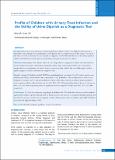Please use this identifier to cite or link to this item:
https://hdl.handle.net/20.500.14356/1883Full metadata record
| DC Field | Value | Language |
|---|---|---|
| dc.contributor.author | Ojha, A R | - |
| dc.contributor.author | Aryal, U R | - |
| dc.date.accessioned | 2023-05-30T07:23:29Z | - |
| dc.date.available | 2023-05-30T07:23:29Z | - |
| dc.date.issued | 2014 | - |
| dc.identifier.citation | OjhaA. R., & AryalU. R. (2015). Profile of Children with Urinary Tract Infection and the Utility of Urine Dipstick as a Diagnostic Tool. Journal of Nepal Health Research Council. https://doi.org/10.33314/jnhrc.v0i0.545 | en_US |
| dc.identifier.issn | Print ISSN: 1727-5482; Online ISSN: 1999-6217 | - |
| dc.identifier.uri | http://103.69.126.140:8080/handle/20.500.14356/1883 | - |
| dc.description | Original Article | en_US |
| dc.description.abstract | Abstract Background: Urinary tract infection is a common problem in children and its early diagnosis and treatment is important to prevent long-term complications. Urine dipstick can be an important tool in this respect. The aim of this study is to look at the utility of urine dipstick as a diagnostic tool for UTI and will also see the clinical profile of children with UTI and sensitivity pattern of antibiotics among the isolates of urine culture. Methods: Urine samples of all children below 14 years of age who were suspected of urinary tract infection were sent for routine microscopic examination and dipstick testing. Urine culture and sensitivity were sent for those samples that were tested positive for nitrite, leucocyte esterase activity or both. For every fifth sample, which is dipstick negative, a culture and sensitivity testing was done. Results: Among 110 children enrolled, 32(29%) cases had significant bacteriuria. Out of 32 culture positive cases 18(56%) were female. Fever was the main complaint (62.5%)). Escherichia Coli was isolated in 81.25% of cases. Amikacin was sensitive in 93% and amoxicillinwas resistant in 82%. The sensitivity, specificity, positive predictive value, negative predictive value of nitrite test was 65%, 80%, 58%, 85% respectively; those of leucocyte esterase are 84%, 55%, 43%, 89% respectively; those for significant microscopic pyuria >10/hpf were 65%, 74%, 51%, 84% respectively. Conclusions: E. Coli is the commonest uropathogen in children with UTI. Amikacin is the most sensitive antibiotic against all the isolates. A positive dipstick both for nitrite and leucocyte esterase is associated with high sensitivity and specificity for urinary tract infection as compared to either of them positive alone. In addition, urine WBC =10/hpf is associated with high probability of UTI.  Keywords: dipstick; sensitivity; specificity; urinary tract infection. | en_US |
| dc.language.iso | en | en_US |
| dc.publisher | Nepal Health Research Council | en_US |
| dc.relation.ispartofseries | Sep-Dec, 2014;545 | - |
| dc.subject | Dipstick | en_US |
| dc.subject | Sensitivity | en_US |
| dc.subject | Specificity | en_US |
| dc.subject | Urinary tract infection | en_US |
| dc.title | Profile of Children with Urinary Tract Infection and the Utility of Urine Dipstick as a Diagnostic Tool | en_US |
| dc.type | Journal Article | en_US |
| local.journal.category | Original Article | - |
| Appears in Collections: | Vol. 12 No. 3 Issue 28 Sep - Dec, 2014 | |
Files in This Item:
| File | Description | Size | Format | |
|---|---|---|---|---|
| 545-Article Text-939-1-10-20150420.pdf | Fulltext Download. | 328.37 kB | Adobe PDF |  View/Open |
Items in DSpace are protected by copyright, with all rights reserved, unless otherwise indicated.
